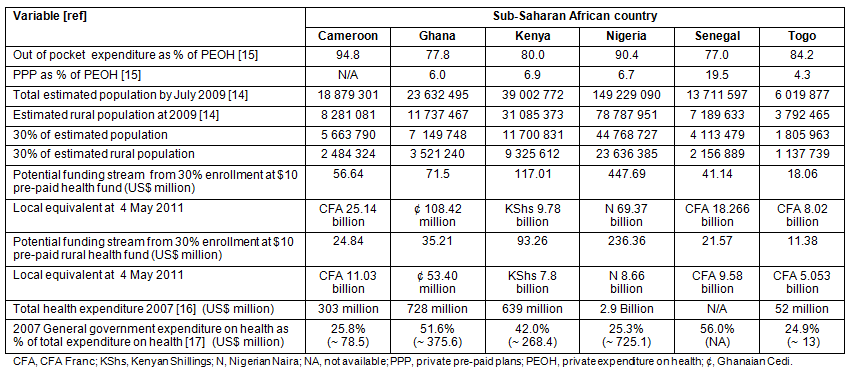Dear Editor
It is often said that for public health policy to be credible and acceptable it has to satisfy the criteria of equity, quality and efficiency. However, some studies indicate that many Sub-Saharan African (SSA) countries are unlikely to internally generate the required funding to provide efficient and quality health services1-3. Such countries may be unable to guarantee the required equity in financial contribution to enable universal health coverage (UHC)4,5, leading to increasing private spending on health care.
Related studies show that episodic treatment for diseases such as malaria may cost families in SSA between US$17 and US$93 per household6,7, with the impact being greater on rural and remote populations where household income will often be inadequate to meet such expenditure. However, even with private contributions, the quality of SSA health services will be inadequate due to the endemic financial and management challenges such as personnel retention8, quality assurance9, stewardship10 and technical inefficiency11.
Differing approaches have been considered to enable UHC, such as sustainable funding models and advocacy for revenue from hypothecated, sector-specific and excise taxes12. However, because private expenditure on health continues to exceed government expenditure in most SSA countries, to ensure the sustainability of UHC in the rural and remote regions of 6 SSA countries (Table 1) a '$10 dollar prep-paid plan' for free basic health services is suggested, with the following assumptions:
- Although $10 is less than the World Health Assembly (Resolution WHA 58.33) ideal, it is better than no contribution.
- Subscribers will be willing to pay this in order to receive better quality health care13.
- Subscription contributions can be made easily via dedicated GSM (Global System for Mobile communication ) pre-paid cards/starter packs, with postal confirmation certificates to reduce administrative costs.
- The funds generated will increase the sustainability of rural health services provided there are explicit mechanisms to ensure expenditure for specific purposes, such as access to medicines and rural personnel retention.
- All enrollees, including those paid for by family, community members or purpose-specific social welfare grants, are covered irrespective of their demographic characteristics.
Table 1: Potential revenue streams for a 'US$10 pre-paid plan' if 30% of estimated total and rural populations
voluntarily enroll for 6 Sub-Saharan African countries14-17

Analysis using 2009 total and rural populations14 for the 6 SSA countries (all with an out-of-pocket health expenditure as a percentage of private expenditure on health of 70% or more, as well as private pre-paid plans less than 20% coverage by 2006)15, shows that if 30% of the total and rural estimated populations in several SSA countries enroll in such a scheme, the revenue stream would be significant, compared with total government expenditures16,17 (Table 1). Therefore, if appropriate mechanisms ensure the retention of such funds for dedicated expenditure on rural health services, and wider managerial issues are addressed9, a significant impact will be made on the sustainability of rural health services, including access to medicines18 and improved personnel retention7.
Anthony Umunna, MA
Ministry of Health & Social Welfare, Lesotho
References
1. Lu C, Schneider MT, Gubbins P, Leach-Kemon K, Jamison D, Murray CJL. Public financing of health in developing countries: a cross-national systematic analysis. Lancet. 2010; 375: 1375-1387.
2. Mathauer I, Doetinchem O, Kirigia J, Carrin G. Feasibility assessment and financial projection results for a social health insurance scheme in Lesotho. Geneva: WHO; 2007 Commission on Macroeconomics and Health.
3. WHO. Macroeconomics and health: investing in health for economic development. Geneva, 2001; 167-169. Available: http://www.earth.columbia.edu/sitefiles/file/about/director/pubs/CMHExecSumm112603.pdf (Accessed 17 January 2012).
4. Xu K, Evans D, Carrin G, Aguilar-Rivera AM, Musgrove P, Evans T. Protecting households from catastrophic health spending. Health Affairs 2007; 26: 972-983.
5. Leive A, Xu, K. Coping with out-of-pocket health payments: empirical evidence from 15 African countries. (Online) 2008. Available: http://www.who.int/bulletin/volumes/86/11/07-049403/en/ (Accessed 08 June 2010).
6. Akazili J, Aikins M, Binka FN. Malaria treatment in Northern Ghana: what is the treatment cost per case to households? African Journal of Health Sciences 2007; 14(1-2): 70-79.
7. Goodman C, Coleman P, Mills A. Economic analysis of malaria control in Sub-Saharan Africa. Global forum for health research: promoting research to improve the health of the poor. Geneva: WHO, 2000.
8. McCoy D, Bennett S, Witter S, Pond B, Baker B, Gow J et al. Salaries and incomes of health workers in sub-Saharan Africa. Lancet 2008; 371: 675-681.
9. Omaswa F, Burnham G, Baingana G, Mwebesa H, Morrow R. Introducing quality management into primary health care services in Uganda. Bulletin of the World Health Organisation 1997; 75(2): 155-161.
10. Gilson L. Management and health care reform in Sub-Saharan Africa. Social Science & Medicine 1999; 40:(5): 695-710.
11. Hsu J. The relative efficiency of public and private service delivery. World Health Report background paper 39. Geneva: WHO, 2010.
12. Stenberg K, Elovainio R, Chisholm D, Fuhr D, Perucic A, Rekve D et al. Responding to the challenge of resource mobilization: mechanisms for raising additional domestic resources for health. World Health Report background paper 13. In: Health Systems Financing. The path to universal coverage. Geneva: WHO, 2010.
13. Mehrotra S, Jarrett SW. Improving basic health service delivery in low-income countries: voice to the poor. Social Science & Medicine 2002; 54(11): 1685-1690.
14. World Bank. Population data. (Online) 2009. Available: http://data.worldbank.org/indicator/SP.POP.TOTL (Accessed 9 May 2011).
15. WHO. World health statistics. Geneva: WHO, 2009; 107-115.
16. Amico P, Aran C, Avila C. HIV spending as a share of total health expenditure: an analysis of regional variation in a multi-country study. PLoS ONE 2010; 5(9): e12997.
17. WHO. World health statistics. Geneva: WHO, 2010; 130-137.
18. Vialle-Valentin CE, Ross-Degnan D, Ntaganira J, Wagner AK. Medicines coverage and community-based health insurance in low-income countries. Health Research Policy and Systems 2008. Available: http://www.health-policy-systems.com/content/6/1/11 (Accessed 20 May 2010).
